When you’re in the midst of your 30s, experiencing gnawing lower back pain is often taken as a fact of life. Whether you bent over to pick a sock or your dog off the ground, you’re bound to wake up with aches the next day— or so the folklore goes.
This tale isn’t entirely untrue. In a 2019 survey conducted by the National Center for Health Statistics, 39 percent of adults reported experiencing back pain in the previous three months. It was the most prevalent site for pain, and the number of people dealing with it only increased with age.
But there is good news: Lumbar pain, in particular, is treatable and, oftentimes, preventable, says Grayson Wickham, PT, DPT, CSCS, a physical therapist and the founder of Movement Vault.
Ahead, learn more about the potential causes behind your discomfort and the best stretches for lumbar pain.
What causes lower back pain to begin with?
Like all pain, lower back pain is multifaceted and may be attributed to more than one cause. Commonly, lumbar pain is brought on by sprains, strains, fractures, herniated discs, sciatica, traumatic injury, osteoarthritis, scoliosis, and lumbar spinal stenosis, according to the American Association of Neurological Surgeons.
In many cases, though, lower back pain often boils down to a sedentary lifestyle, Wickham says. When you spend most of your time sitting in a chair with your hips and knees bent at about 90 degrees, your hip flexor and hamstring muscles gradually adapt to this position and ultimately shorten (read: tighten), he explains.
By constantly using a backrest, your core musculature doesn’t need to work and, over time, weakens. So your ability to activate those muscles when you need them—like when you’re lifting a heavy object—also declines, he says. Plus, the movement you do engage in may lack variety; you might be running, walking, or performing push-ups, squats, and lunges, activities that all take place in the sagittal plane of motion and neglect rotation or side-to-side movement.
In turn, you can end up with a combination of poor core stability and activation, tight (and often weak) hips and hamstrings, and tight, unstable joints that aren’t used to moving in all planes of motion, Wickham says. Then, when you reach to the side and try to pick a heavy box or your child off the ground, you lack the hip mobility and hamstring flexibility necessary to get into a safe starting position and the core stability to protect your spine.
“Now, another joint has to compensate for your tight hips, and that’s typically the low back,” Wickham says. “You’re basically picking up objects using your low back in a rounded position, which isn’t a great position for the back for most people.” Cue: Lower back pain and discomfort.
Lower back pain may also be influenced by how you move. Folks who worry about hurting their back may move with rigidity and stiffness throughout their spine, which can do more harm than good, says Andy Fata-Chan, PT, DPT, a physical therapist and the founder of Moment Physical Therapy and Performance in New York City.
“If we try to guard everything, we try to keep as much tension as possible, we end up moving like robots, which is not sustainable,” he notes. “So we [as physical therapists] spend a lot of time unteaching that tension by getting the spine to move through flexion, extension, side to side, [and] rotation.”
Similarly, lower back pain may develop if you’re creating movement from one segment of your spine rather than the entire structure, Fata-Chan says. When extending your back, for instance, the movement may stem solely from the lumbar spine, increasing stress on this area, rather than the lumbar, thoracic, and cervical sections.
How to relieve lower back pain
Working on maintaining healthy posture and standing throughout the day can help relieve and prevent lower back pain. But regularly performing an active stretching routine—an antidote to the lack of varied movement in your everyday life—is key, Wickham says.
At the beginning of the rehab process, Wickham generally recommends muscle and fascia release techniques, targeting your glutes, obliques, and quadratus lumborum (a deep back muscle) to acutely decrease pain. Then, he suggests moving onto active stretching and muscle activation exercises that get to the root cause of your lower back pain; focus on working to improve hip and ankle mobility, core stability and activation, and the flexibility and strength of the hips, hamstrings, glutes, quads, adductors, and spinal erector muscles through a full range of motion.
Being dynamic with your spinal movement throughout the day and your stretch routine is also important, Fata-Chan says.
“If I keep my back in this very neutral position, it’s really, really tough to feel comfortable and relaxed because you’re not dynamic like you normally should be,” he says. “I utilize a lot of different [overhead or lateral] reaches in different angles in order to influence different parts of the spinal column.”
Consider treating your spine to one rotation and one side-to-side movement and exploring flexion and extension, he adds.
TL;DR: “Find two to four movements that feel tight, a little bit restricted, and just keep working on them daily until they feel normal. Then, add them back into the routine as needed,” Fata-Chan suggests.
The definitive best stretches for lumbar pain
Try some of Wickham’s go-to stretches for lumbar pain, which he demonstrates below. Start with the muscle and fascia release techniques to address acute pain before moving on to a few of the active stretches and muscle activation exercises, he recommends.
“It’s important with all of these active stretches to get as deep into the stretch as possible without pain and then contract the stretched-out muscles,” he notes.
Remember to move with control, and if you need to modify any of the stretches for lumbar pain, decrease your range of motion.
“Listen to your body and be able to pull back if you need to,” Fata-Chan says. “If you move slowly, you can explore it more safely.”
1. Quadratus lumborum and oblique muscle and fascia release
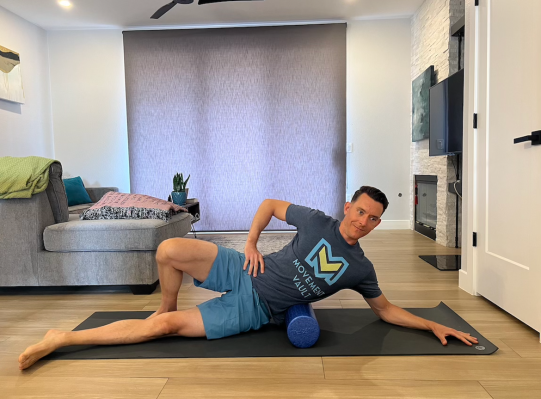
- Lie on your left side with a foam roller placed on the floor right above your left hip.
- Start with your left leg fully extended on the floor, your right leg bent at about 90 degrees, and your right foot placed on the ground.
- Place your right hand on your hip and left elbow on the floor above your left shoulder, your forearm resting on the floor.
- Gently foam roll the entire area between the top of your hips and your ribs, slowly moving from the left side of your body to your back.
- Continue for 2 minutes. Switch sides; repeat.
2. Gluteus muscle and fascia release
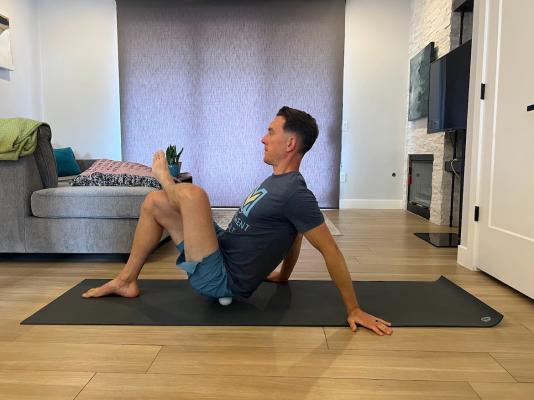
- Lie face up on the floor with a mobility ball placed underneath your left glutes, your legs bent, and your feet resting on the ground.
- Slowly move your leg inward and outward while lying on the ball.
- To progress, sit up with your left leg crossed over your right and your left ankle resting above your right kneecap. Roll side to side until you find a tender spot. Briefly pause before continuing to roll side to side.
- Continue for 2 minutes. Switch sides; repeat.
3. Active hamstring stretch
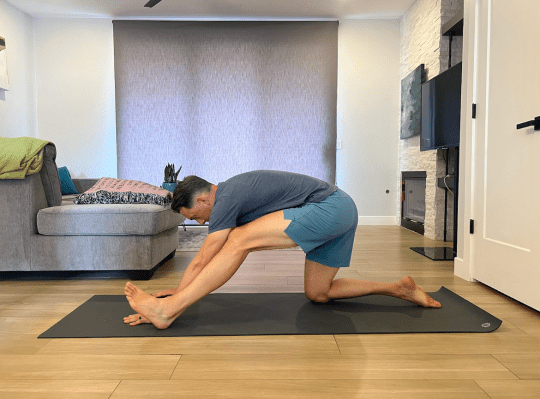
- Start in a kneeling position on the floor with your calves extended behind you and the tops of your feet resting on the ground.
- Extend your left leg in front of you, your heel resting on the ground and your toes pointing toward the ceiling.
- Hinge forward at the hips to lower your chest toward your thigh, placing your hands on the floor next to your left leg.
- Once maximally stretched out, drive your heel downward, causing your hamstring muscles to contract.
- Hold this contraction for 20 seconds, then release. That’s one rep.
- Do three 20-second holds per side. Switch sides; repeat.
4. Active adductor stretch
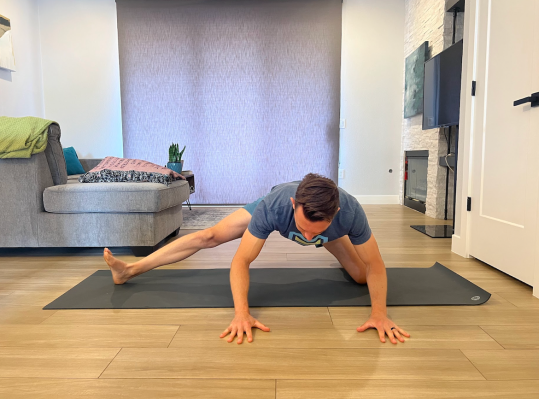
- Start in a kneeling position on the floor with your calves extended behind you and the tops of your feet resting on the ground.
- Extend your right leg out to the side, your heel resting on the ground and your toes pointing toward the ceiling.
- Hinge forward at the hips until your back is in line with your hips, placing your hands on the ground in front of your chest.
- Once maximally stretched out, drive your right heel downward, causing your adductor muscles to contract.
- Hold this contraction for 20 seconds, then release. That’s one rep.
- Do three 20-second holds per side. Switch sides; repeat.
5. Active hip flexor stretch
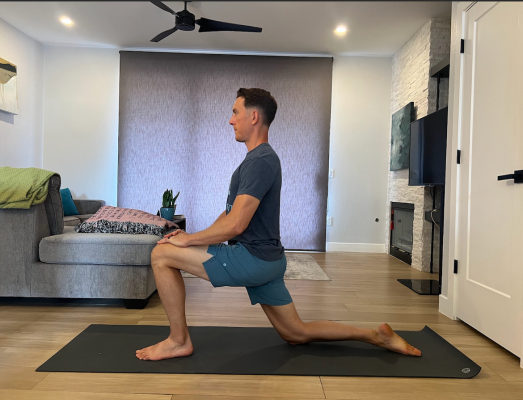
- Start in a kneeling position on the floor with your calves extended behind you and the tops of your feet resting on the ground.
- Step your left foot onto the floor in front of you, bending your left knee to 90 degrees. Rest your hands gently on your left thigh.
- Keeping your shoulders and hips stacked, shift your weight into your front foot, feeling a stretch in your right hip flexors.
- Once maximally stretched out, kick your right foot into the ground, causing your hip flexor muscles to contract.
- Hold this contraction for 20 seconds, then release. That’s one rep.
- Do three 20-second holds per side. Switch sides; repeat.
6. Prone press-up
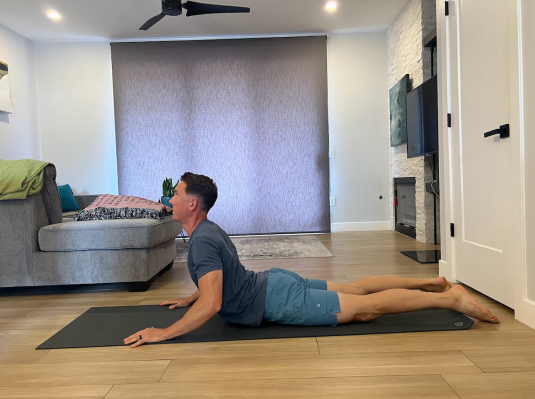
- Lie face-down on the floor with your legs extended behind you, your elbows tucked into your sides, and palms on the ground next to your head.
- Gently pressing into your palms and lifting your chest, arch your back as much as possible without pain. Gaze forward.
- Hold this position. Contract your spinal erector muscles that run on both sides of your spine to increase your arch for 5 seconds, then release. That’s one rep.
- Do 10 5-second holds.
7. Cat-camel hold (extension only)
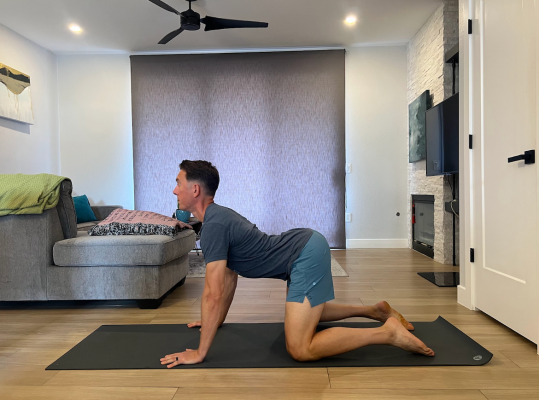
- Start in a tabletop position on the floor with your shoulders stacked with your wrists and your hips stacked with your knees. Gaze forward.
- Keeping your chest lifted, arch your back as much as possible without pain.
- Hold this position. Contract your spinal erector muscles that run on both sides of your spine to increase your arch for 5 seconds, then release. That’s one rep.
- Do 10 5-second holds.
8. Bridge hold
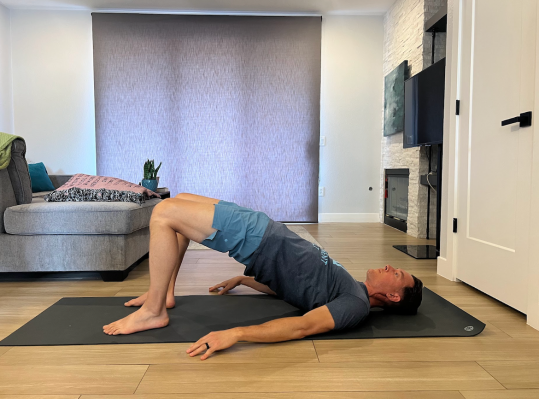
- Lie face-up on the floor with your arms extended at your sides, your knees bent, and your feet planted on the ground a few inches in front of your glutes.
- With your core engaged, press through your heels to drive your hips toward the ceiling. Continue driving your hips up until your body forms a straight line from your knees to your chin.
- Hold this position. Drive your feet into the ground while slightly dragging your heels toward your hips to contract your glutes for 5 seconds.
- Release the contraction, then slowly lower your hips back to the floor. That’s one rep.
- Do 10 5-second holds.
9. 90-90 active stretch (front leg only)
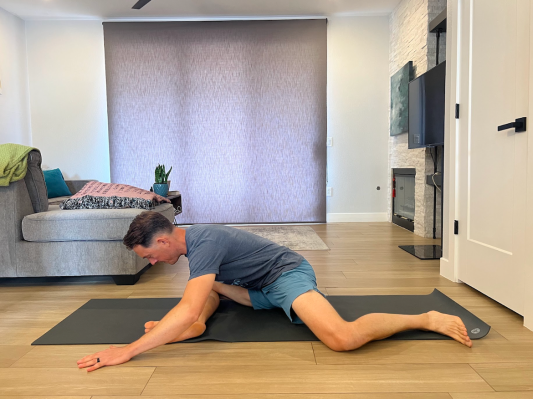
- Sit on the floor with your right leg bent at a roughly 90-degree angle in front of you, your right knee in line with your right hip. Extend your left leg out to the side, bending your knee to about 90 degrees so your left foot points behind you.
- Keeping your back flat, hinge forward at the hips, bringing your chest toward your right leg. Place your hands on the floor next to your right foot and knee.
- Once maximally stretched out, drive your right calf down into the ground, causing your hamstring muscles to contract.
- Hold this contraction for 20 seconds, then release. That’s one rep.
- Do three 20-second holds per side. Switch sides; repeat.
10. Full-range-of-motion hip activation
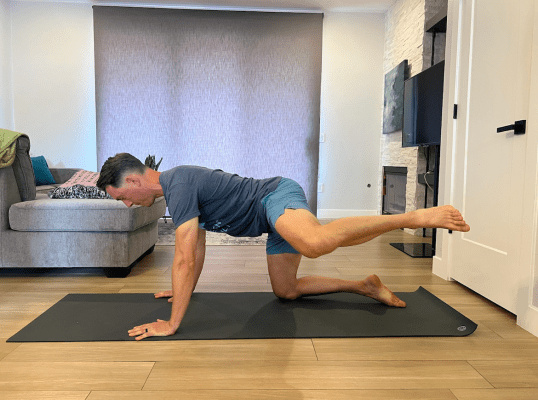
- Start in a tabletop position on the floor with your shoulders stacked with your wrists and your hips stacked with your knees. Engage your core and gaze at the floor.
- Keeping your left knee bent and back flat, lift your left leg out the side. Then, focus on making the biggest pain-free hip circle possible. All of the motion should be coming from your hip.
- Slowly make a hip circle in one direction, then the other. That’s one rep.
- Do 5 reps. Switch sides; repeat.
11. Side bend hold
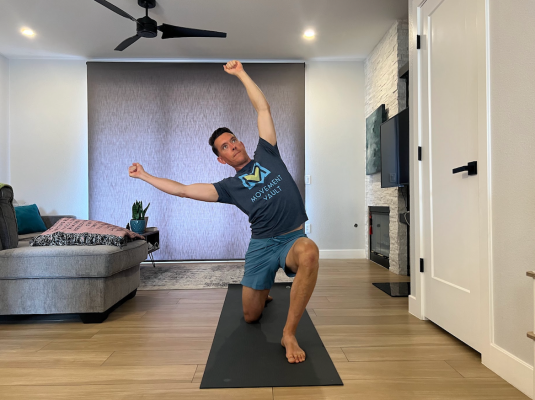
- Start in a kneeling position on the floor with your calves extended behind you and the tops of your feet resting on the ground.
- Step your left foot onto the floor in front of you, bending your left knee to 90 degrees. Extend your arms above your head.
- Keeping your hips and knees stable, bend through your spine away from the painful side. Contract the muscles on the side of your body that you are bending toward while your opposite arm punches up and over.
- Hold this contraction for 5 seconds, then release. That’s one rep.
- Do 10 5-second holds.
Safety tips to keep in mind when performing stretches for lumbar pain
If any stretches you’re practicing for lower back pain are exacerbating your symptoms, that particular movement either isn’t right for you at that moment or you need to modify it (think: shortening your range of motion), Wickham says.
You might experience some muscle soreness after performing, say, a hip mobility exercise in which you’re activating the glute muscles. However, “you never want to have increased pain, increased numbness, tingling, or burning during the exercise or right after you perform the exercise, as well as within a 24-hour period after,” Wickham explains. In that case, take it as a sign to book an appointment with your healthcare provider.
FAQ
1. Is stretching good for lumbar pain?
Performing active stretches that build flexibility and strength through a full range of motion can help relieve pain in the lumbar spine, also known as the lower back. Make sure to combine these movements with muscle and fascia release techniques to acutely decrease pain.
Importantly, static stretching isn’t the answer to lower back pain relief. “When you’re static stretching, aka passive stretching, you’re essentially just lengthening a muscle and relaxing and breathing into it,” Wickham says. “So you’re actually not improving your muscle activation. You’re not improving joint stability [as you would with active stretching].”
It may feel relaxing, but getting that activation, stability, and mobility up to snuff is essential to mitigating lower back pain.
2. When should you not stretch with lower back pain?
If you experience muscle weakness, numbness, burning, tingling, or a loss of sensation in your legs, skip the at-home stretch routine for your lower back pain and meet with your healthcare provider, as you may be dealing with a disc bulge or herniation (like sciatica) affecting your nerves, according to the experts.
You’ll also want to get checked out by a professional if you have a history of cancer, you’re waking up in the night with pain, or you have a fever—a sign you could have a spinal infection, Fata-Chan adds.
3. What should you not do with lower back pain?
Typically in the acute stage of lower back pain, rotating through the spine and bending to the side may worsen symptoms, Wickham says. However, certain ranges of motion may aggravate your symptoms depending on the flavor of your lower back pain. Some people may experience worse discomfort during low back flexion (e.g., bending forward), while low back extension (e.g. bending backward) can provide relief, he says.
If your pain is caused by a disc bulge on your right side, bending to the right can exacerbate symptoms due to nerve compression while bending to the left can ease compression and provide relief, Wickham says. Avoid any movements or stretches that worsen your pain and seek out guidance from a healthcare provider if necessary.
